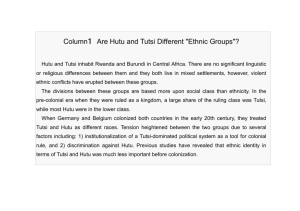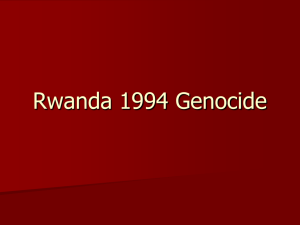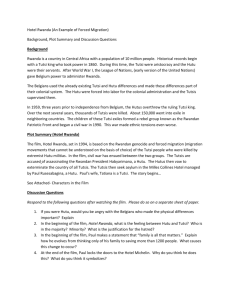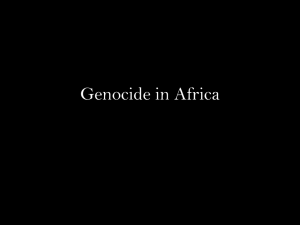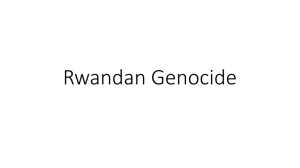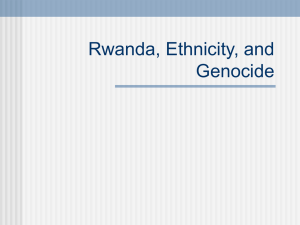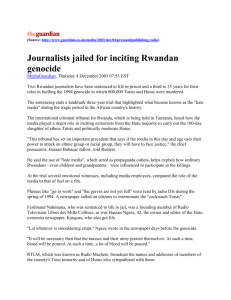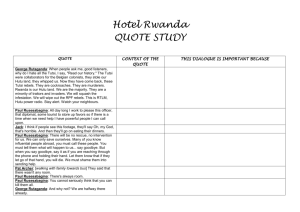HUTU & TUTSI
advertisement
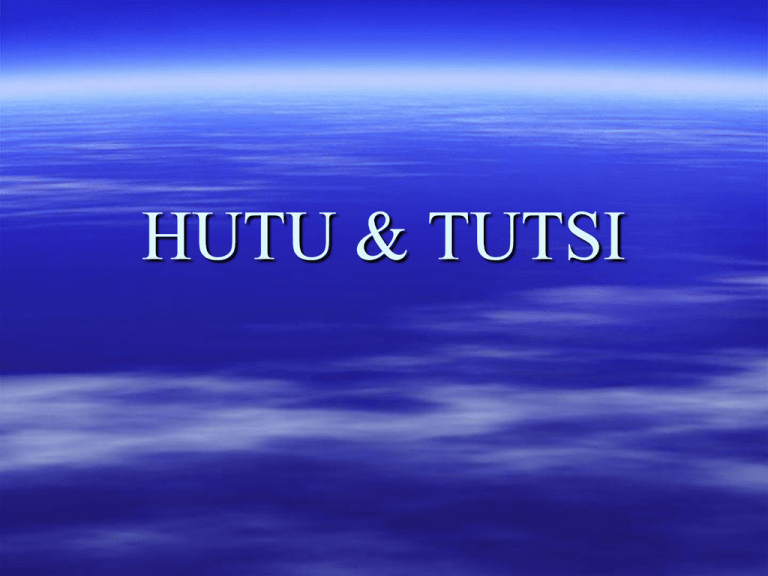
HUTU & TUTSI Rwanda What’s going on? Background information When German explorers first came to Rwanda they observed in the royal court a ruling class, the Tutsis, and a subservient class, the Hutus. This class structure was maintained by the Belgians and the French missionaries who followed, supporting as they did the Tutsi minority governing class. Massacre The Rwandan Genocide was the massacre of an estimated 800,000 to 1,071,000 ethnic Tutsis and moderate Hutus in Rwanda, mostly carried out by two extremist Hutu militia groups during a period of about 100 days from April 6th through mid-July 1994. Continue The Hutus make up about 85% of Rwanda’s population, but they were denied higher education, land ownership and positions in government. Racial Classification Belgians colonists divided Rwanda’s unified population into three distinct groups: Hutu, Tutsi, and Twa Belgians and Germans influenced by racist ideas, thought that the Tutsi were a superior group because they were more “white” looking. Continue The size of the nose and the color of the eyes were factors that determined whether a person was classified as Hutu, Tutsi, or Twa. The colonists believed that the Tutsi were natural rulers, so they put only Tutsis into positions of authority and discriminated against Hutus and Twa. Independence and Hutu Rule 1959, violence between the Tutsi and Hutu erupted. Hutu overthrew Tutsi rule, declared an independent republic and elected first Hutu president Mass killings of Tutsis occurred during the transition to Hutu rule, hinting things to come. Vocabulary Genocide = the deliberate and systematic extermination of a national, racial, political, or cultural group. Refugee= a person who flees for refuge or safety, esp. to a foreign country, as in time of political upheaval, war, etc. Continue United Nations = The United Nations High Commissioner for Human Rights works to strengthen and coordinate United Nations work for the protection and promotion of all human rights of all persons around the world. The Secretary-General has made human rights the central theme that unifies the Organization’s work. Natives The Tutsi are one of three native peoples of the nations of Rwanda and Burundi in central Africa, the other two being the Twa and the Hutu. The Twa (or Batwa) are a pygmy people and the original inhabitants. The Hutu (or Bahutu) are a people of Bantu origin, and since they moved into the area they dominated the Twa. Large numbers of all three were slaughtered in the Rwandan Genocide of 1994. Tutsi The division between the Hutu and the Tutsi, the larger of the other two groups, is based more upon social class than ethnicity The Tutsi were people who migrated south from what is now Ethiopia, conquering the Hutu kingdoms and establishing dominance over the Hutu and Twa between the 1400's and the 1700's. Hutu The Hutu are the largest of the three ethnic groups in Burundi and Rwanda The Hutu ruled the area with a series of small kingdoms until the arrival of the Tutsi Continue The Germans and Belgians colonial powers both preferred the Tutsi and rewarded them with positions of power, once Rwanda was granted independence in 1962, battle for control over the government, control over the land and cattle, and control over the social standings began. Rwanda Genocide Rwanda's 100 days of genocide began shortly after President Juvenal Habyarimana's plane was shot down on 6 April 1994. As civil war continued between the mainly-Hutu government and the Tutsi-led rebel RPF, Hutu militias began an orchestrated killing campaign. About 800,000 Tutsis and moderate Hutus were killed. Continue In the weeks prior to the attacks, the UN did not respond to reports of Hutu militias. The genocide ended when a Tutsidominated the rebel movement known as the Rwandan Patriotic Front, led by Paul Kagame, overthrew the Hutu government and seized power. Rwanda Genocide During the Rwandan Genocide of 1994, United Nations peacekeepers stepped back as Hutu extremists hundreds of thousands of Tutsis as well as moderate Hutu politicians. As of 2006, violence between the Hutu and Tutsi has subsided, but the situation in both Rwanda and Burundi is still tense, and tens of thousands of Rwandans are still living outside the country. Bibliography http://en.wikipedia.org/wiki/Rwandan_Genoc ide 1. Which group of people did the Belgians think were a superior group? 2. Why did they think they were a superior group? 3. Which group declared an independent republic in 1959? 4. Explain the Rwandan genocide. 5. Which group was the largest ethnic group represented, Huti or Tutsi? 6. What determined the classification of each group?
